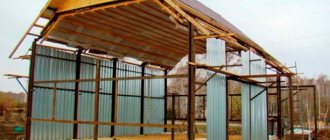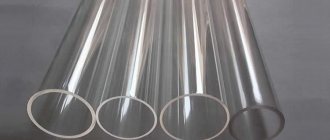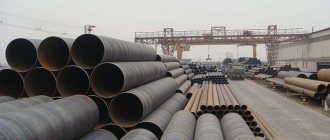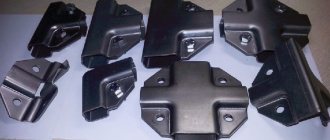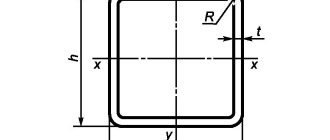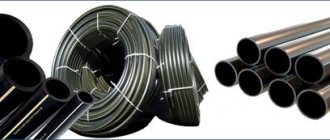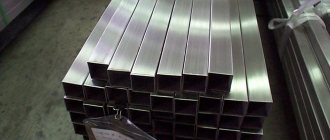Anti-advertising against asbestos has done its job. Building materials made from asbestos components began to leave the market, but this did not affect asbestos-cement pipes. Because these products have a fairly wide list of advantages, and they are also made from white asbestos - chrysotile, which, as scientists have proven, is not dangerous to human health.
The raw material for the production of asbestos-cement pipes is fiber cement mortar, which contains asbestos fibers in a volume of 15-20% of the volume of Portland cement used. The production of pipes is not very complicated, which affects the cost of production. Therefore, the price of asbestos-cement pipes is several times less than that of metal ones.
Production and composition of asbestos-cement pipes
In nature, asbestos is a durable material that consists of a large number of thin fibers and belongs to the class of minerals.
Asbestos is resistant to rupture, and the connection with cement allows you to create products with a long service life and good technical characteristics. This material is used in many industries, such as construction and rocket science. With a low content of asbestos and various impurities, the products have a low price and are widely popular. The composition of asbestos-cement pipes is as follows:
- 15% asbestos produced using special technology;
- 85% cement;
- required amount of water.
When manufacturing asbestos-cement products, the proportions are carefully maintained and the layer of mineral on the cement is uniform. Pipelines made from this material are available in various diameters, from 100 mm to 500 mm. The length of the finished product is also strictly regulated, it can be 3.95 or 5 m. To connect the pipeline, special couplings made of the same material are used. The size of the couplings is slightly larger than the pipes themselves; this design is made to simplify installation.
Asbestos-cement pressure pipes (VT-6, VT-9, VT-12) GOST 31416-2009
Pressure pipe VT-6 d100pipe31.0050—650848.00 Pressure pipe VT-6 d150pipe51.0025—4001308.00 Pressure pipe VT-6 d200pipe122.001802910.00 Pressure pipe VT-6 d250pipe180.00——12 04968.00 Pressure pipe VT-6 d300 pipe 212.00 ——755212.00Pressure pipe VT-6 d400pipe364.00——458340.00Pressure pipe VT-6 d500pipe536.00——301588600Pressure pipe VT-9 d100pipe45.0055—5501180.00Pressure pipe VT-9 d15 0pipe67.0033—3301596.00 Pressure pipe VT-9 d200pipe141.00——1703182.00Pressure pipe VT-9 d250pipe169.00——1205912.00Pressure pipe VT-9 d300pipe239.00——706110.00Pressure pipe VT-9 d400pipe409.0——361044 0.00 Pressure pipe VT- 9 d500pipe624.00——2616285.00Pressure pipe VT-12 d100pipe46.005510550order 7-15 days Pressure pipe VT-12 d150pipe81.003310330order 7-15 days Pressure pipe VT-12 d200pipe150 ,00——170order 7-15 days. Pressure pipe VT-12 d250 pipe 204.00——120 order 7-15 days. Pressure pipe VT-12 d300 pipe 290.00——80 order 7-15 days. Pressure pipe VT-12 d400 pipe 506.00——45 order 7-15 days. Pressure pipe VT-12 d500pipe824.00——30order 7-15 days.The main advantages of asbestos cement pipes
Asbestos, in combination with cement, creates serious competition for materials such as metal and plastic, as it has a longer service life and lower price. In an aggressive environment, this product does not lose its beneficial qualities. Asbestos-cement pipes are very easy to process and their installation does not take much time.
Advantages of asbestos-cement pipes:
- Resistant to corrosion. Asbestos and cement are materials whose structure is not susceptible to rust, rot and the appearance of harmful microorganisms and bacteria. Since the pipes are located in the ground or other aggressive environment, this quality is very important.
- Minimum expansion factor. After a long period of time and exposure to heat and cold, asbestos-cement pipes do not change their structure. Metal products are subject to constant temperature changes, which negatively affects their durability.
- Low material cost. Asbestos, combined with cement and water, has a much lower price than metal or plastic, even of the lowest quality. The production of asbestos-cement products does not take much time and requires a small amount of equipment and workers.
- Light weight. This criterion is very important, as it saves time and money when transporting finished products.
- Low thermal conductivity. Because of this quality, asbestos-cement pipes do not freeze during cold periods of the year.
- Long service life. The correct combination of asbestos and cement, as well as increased corrosion resistance, ensures the durability of the material.
- Wide variety of products. This applies not only to the pipes themselves, but also to the couplings. A large number of pipe sizes and internal diameters allows customers to select the most suitable options.
- Easy to install. Asbestos can be cut with a simple construction tool and is very convenient to drill. For installation, couplings are used, which do not require much time to secure.
- No maintenance required. Asbestos-cement surfaces are not prone to the accumulation of harmful deposits, and the material itself does not require periodic cleaning or treatment.
In addition to the positive qualities described above, asbestos-cement pipes also have certain disadvantages. For example, the low strength of this material. If the proportions are not respected, the pipes become fragile, which creates additional problems both during transportation and installation. Also, during manufacturing, it is not always possible to create the correct pipe diameter. This defect becomes noticeable only after the material has completely cooled. Sometimes the pipes may have a slight curvature. Incorrect diameter and uneven surface are consequences of poor installation.
Applications and Benefits
Public and private enterprises use asbestos cement for systems such as water supply networks, gas pipelines, sewerage, in agriculture, and ventilation chimneys.
Experimental production of asbestos cement pipes began in Italy in 1913. Progress was rapid, and by 1921 asbestos-cement pipes were adopted everywhere in Europe. It was assumed that the expected service life would be about seventy years. Even today, asbestos cement remains a part of many city water supplies, and these pipes are now beginning to reach the end of their useful life. Most municipalities have been working on removing and replacing these pipes for the past thirty years.
Asbestos cement has gradually replaced both metal and ceramic piping in a large number of installations due to the fact that:
- corrosion resistant
- are immune to electrolytic action and are not affected by burial in the ground
- are light in weight
- elasticity, strength, compression resistance
- economical to install
- resistant to temperature changes
They are not affected by the usual corrosive factors found in soils and waters, which attack metal pipes and cause them to deteriorate after a few years.
Tests were carried out on pipes after 30 years of operation with the conclusion that they retained their original properties. Asbestos cement has a smooth, glossy cylindrical internal surface and has very low hydraulic frictional resistance to fluid flow.
Asbestos cement pipes are still in use throughout the world. Their experimental data shows that capacity increases are 25% greater than new cast iron pipes and 30-60% greater than older ones, all with the same internal diameter.
How to prepare and install asbestos pipes
Asbestos pipes are quite easy to work with. It is necessary to have a minimum amount of tools and follow the recommendations. Before laying the pipe in a ditch, you should make sure that the surface is smooth and has no bulges or sharp bends. If such defects are present in the ditch, the pipe may burst, since asbestos is known for its fragility. For a better effect, a sand cushion can be created at the bottom of the ditch. This will not only protect the pipes from mechanical damage during installation, but will also create an additional thermal insulation layer. To cut asbestos-cement pipes, it is enough to use an ordinary hacksaw; to speed up the process, you can use a grinder. The only problem is the frequent replacement of wheels, since asbestos threads have a high density and quickly dull the tool. Also, this material lends itself very well to drilling, which makes the installation process faster. To connect asbestos-cement pipes to each other, specially created couplings made of the same material or rubber are used. In order for the system to last long enough, it is necessary to ensure the correct circumference of the coupling and the pipe itself, as well as their tight fit to each other. The asbestos coupling is equipped with a tightening mechanism that simplifies the installation process. But rubber couplings have increased tightness, which means you don’t have to worry about the system leaking after installation. The only preparatory step before installation is to lubricate the surface of the pipes with a substance based on graphite or glycerin. These materials help simplify the installation of couplings and also serve as additional protection against leakage.
Installation features
Pipe laying is carried out according to certain requirements. These requirements include the following factors:
- Pipes with an internal diameter exceeding 150 mm require additional processing. It is required in order to obtain the appropriate dimensions and roughness.
- The products are connected using special couplings. These couplings are equipped with grooves as well as corresponding rubber sealing rings. For a certain pipe size, appropriate couplings are used. This type of connection design allows for a high-quality fit of the pipe to the coupling, which is important in the presence of internal pressure in the pipeline.
- A radial gap is left at the junction of the products. Such a gap is required in order to ensure deflection of the pipeline when the seal fails.
- Installation of pipes with diameters of more than 150 mm is carried out directly with indentations. This is done for the purpose of eliminating the need to install additional linear compensators.
When asbestos pipes are heated to temperatures above 100 degrees, the walls increase (asbestos modification) by 0.4 mm. To avoid failure of the rubber seal, it is deformed by the end parts by 0.2 mm.
When installing asbestos-cement pipes, the need for welding work is eliminated. This makes the job easier and also speeds up the installation process.
Main types of asbestos-cement pipes
Asbestos pipes are divided into 2 main types:
• Pressure. The manufacturing method involves operating the product under high pressure conditions. This type of pipe is used in water supply and sewer systems, as well as heating mains. Pressure pipes must have ideal dimensions and an accurate internal diameter, otherwise high pressure can damage the integrity of the system. Before sale, each product is pressure tested, and defects are disposed of. Asbestos pressure pipes are equipped with special couplings that make the system more airtight. • Non-pressure. Such pipes are suitable for systems where there is little or no pressure. Non-pressure asbestos pipes are suitable for ventilation systems, as well as for laying gas supply systems. The same products can also have a decorative character, for example, as a fence. Also, free-flow pipes are very often used for the construction of garbage chutes or furnaces in private homes. Free-flow asbestos pipes are used in many industries. It is convenient to use them when improving a private house or when creating an irrigation system for a suburban area. During installation, you can use both polyethylene couplings and asbestos-cement couplings. Holes and cracks can be filled with molten bitumen; it will not harm the product, but will improve the quality of sealing. Installation of free-flow pipes does not create additional difficulties. This material can last up to 40 years.
Scope of application of asbestos cement pipes
Some areas where asbestos cement works can be used have already been mentioned, but this is just a small part. They are used:
- Drainage sewerage. Manufacturers currently offer perforated asbestos-cement products, which are used to collect and remove groundwater and atmospheric precipitation from suburban areas.
- Sewage systems: pressure and non-pressure. This is especially true for pressure sewerage, because asbestos-cement pipes can withstand pressure of up to 15 atm. Therefore, there is no need to install cast iron or steel pipes, which are several times more expensive than asbestos-cement pipes.
- Casing structure for drilling wells and finishing wells.
- The regulations allow the construction of garbage chutes in apartment buildings. This reduces building construction costs.
- Low thermal conductivity and large thickness of asbestos pipes make it possible to use them in chimney structures. At the same time, fire safety requirements are met one hundred percent.
- They are used to construct fences and various fencing structures as pillars.
- They are used to make permanent formwork for pouring columnar foundations and support pillars for floors.
- Designers also pay attention to asbestos-cement pipes. Flowerpots, flower beds, decorative stands, and so on are made from them. Fortunately, these products are easy to process, and this is another advantage.
Myth about the dangers of using asbestos
In many European Union countries, the use of products containing asbestos is prohibited. This material, after lengthy studies, has been recognized as a carcinogen, that is, a substance that can cause a malignant tumor over a long period of time. But the list of the most commonly used carcinogens also includes gasoline, paints and varnishes, some types of rubber, and even salted fish with alcoholic beverages. It is not asbestos itself that is harmful to health, but the dust that arises when working with it. Regular entry of this dust into the lungs can indeed lead to the occurrence of certain diseases. Ordinary asbestos surfaces, for example in water pipes, do not pose any health hazard. Also, asbestos-cement pipes are often buried in the ground, which allows you not to worry about the effect of the material on the human body. For greater safety, asbestos can be painted, which will also improve the appearance of the product.
Nowadays, most often, asbestos based on chrysotile (a material that, in all its characteristics, resembles ordinary talc) is used in construction. Chrysotile is absolutely safe for the body, does not cause diseases and is successfully used in many industries.

